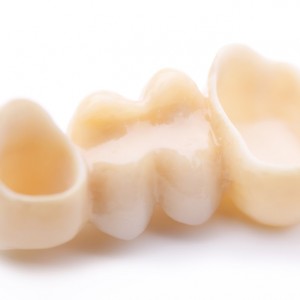Dental Crowns and Dental Prosthetics
There are countless reasons why you might consider a dental crown or prosthetic tooth replacement. Dental crowns are usually inserted to cover a drilled-off part of your tooth, and can even be linked together to create what’s called a dental bridge. Prosthetics are full, false teeth, usually anchored by a dental implant.
If you’ve heard these terms and wondered how they’re different, and what really constitutes as one or the other, you’ve come to the right place. We’ve outlined the basics on dental crowns and dental prosthetics here for you to learn about.
Dental crowns
A dental crown is a fixed prosthetic addition to your tooth that usually covers a drilled-off part. When only one of your teeth is involved, then you’re dealing with a single crown. Linking several crowns together represents a dental bridge.
It’s not only when part of a tooth is missing that patients think about a dental crown. Tooth discoloration or rotation are also common reasons why people have crowns placed. When crowns are put in, your dentist has techniques to ensure that your bite is unaffected. The process is typically regarded as simple and non-invasive.
Materials used in dental crowns
The chosen material for your dental crown will be a type of ceramic, as these materials are long-lasting, attractive, and good for chewing. Ceramics are tolerant to temperature changes and resistant to chemical influences and corrosion, and are also biocompatible, which means you’ll be safe from allergic reactions. Plus, ceramics simulate the appearance of natural tooth, so no one has to notice a difference in your smile.
These are some of the common ceramics used in dental crowns:
- Metal ceramics
These crowns are considered a standard in dentistry, and are also the most affordable solution. - Zircon ceramics
Zircon-oxide ceramics are characterized by extreme durability. The Zirkon base underneath the ceramic coating allows for the reflection of natural light, which keeps the shine in your smile. And while metal ceramics show their silver color along where the crown meets your gums, zircon ceramics are completely white. - 100% ceramics crown Full ceramic crowns have the ability to simulate the look of your natural tooth better than any other for its color, translucence and opalescence. They typically represent the most expensive option. It’s just a matter of consulting with your dentist to choose the option that’s best for you.
Prosthetics and dental implants
The use of multiple prosthetics requires a supportive device rooted into your jaw, which is where dental implants come in. This route is more secure and offers greater stability than a crown ever could. However, if you have any remaining tooth left at the site of the prosthetic, it must be removed in order to place the dental implant.
The placement of dental implants is a more involved process, however if you’re able to consider the surgery, the use of these full-tooth prosthetics is widely considered the best option for tooth replacement. Crowns are quick and non-invasive, but prosthetics anchored by dental implants imitate tooth better in look and function.
Whether you’re considering a dental crown or dental prosthetics, it starts with a consultation with your dentist. We’re fortunate to live in an age where each option enjoys huge success rates, and dentists have more refined tools than ever to make these tooth replacements happen and keep your smile in-tact.
Now that you know the basics, the next step is a simple conversation with your dentist!






